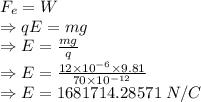
Ahousefly walking across a clean surface can accumulate a significant positive or negative charge. in one experiment, the largest positive charge observed was +70 pc. a typical housefly has a mass of 12mg. a.) explain how the housefly could accumulate an electric charge by walking across a surface? b.) what magnitude and direction electric field would be necessary to levitate a housefly with a maximum charge? could such a field exist in air?

Answers: 2
Another question on Physics

Physics, 22.06.2019 00:30
During spring semester at mit, residents of the parallel buildings of the east campus dorms battle one another with large catapults that are made with surgical hose mounted on a window frame. a balloon filled with dyed water is placed in a pouch attached to the hose, which is then stretched through the width of the room. assume that the stretching of the hose obeys hooke's law with a spring constant of 89.0 n/m. if the hose is stretched by 5.80 m and then released, how much work does the force from the hose do on the balloon in the pouch by the time the hose reaches its relaxed length? unitst 3 number-1497 the tolerance is +/-5% open show work click if you would like to show work for this question:
Answers: 2

Physics, 22.06.2019 11:30
(2) (a) you have a simple circuit that consists of only a battery (δvbat=1.5v) and two resistors with resistance r1=10ω and r2=5ω, connected in series with each other. what is the current running through the battery? (b) you re-arrange your circuit so now r2 is attached in parallel to r1 rather than in series. what is the current running through the battery? (c) you add an additional resistor r3=7ω on the same branch as r2. what is the current running through the battery? (d) what is the power dissipated in r3?
Answers: 3

Physics, 22.06.2019 12:50
Arunner is jogging at a steady 3.6 km/hr. when the runner is 2.9 km from the finish line, a bird begins flying from the runner to the finish line at 14.4 km/hr (4 times as fast as the runner). when the bird reaches the finish line, it turns around and flies back to the runner. even though the bird is a dodo, we will assume that it occupies only one point in space, i.e., a zero-length bird. how far does the bird travel? (b) after this first encounter, the bird then turns around and flies from the runner back to the finish line, turns around again and flies back to the runner. the bird repeats the back and forth trips until the runner reaches the finish line. how far does the bird travel from the beginning? (i.e. include the distance traveled to the first encounter)
Answers: 2

Physics, 22.06.2019 14:30
Exercise 2. find the wavelength of a photon emitted when an electron jumps from the n = 3 energy level down to the n = 2 energy level. where is this photon in the electromagnetic spectrum?
Answers: 3
You know the right answer?
Ahousefly walking across a clean surface can accumulate a significant positive or negative charge. i...
Questions



Mathematics, 03.06.2021 05:00



Mathematics, 03.06.2021 05:00

Medicine, 03.06.2021 05:00

Mathematics, 03.06.2021 05:00








Chemistry, 03.06.2021 05:00

Mathematics, 03.06.2021 05:00

Mathematics, 03.06.2021 05:00

Mathematics, 03.06.2021 05:00


 which is more than the critical value of electric field in air. So, the electric field can exist.
which is more than the critical value of electric field in air. So, the electric field can exist.

